#i remember feeling so like. charlie day conspiracy board the first time i played
Explore tagged Tumblr posts
Text

sentences that made me feel utterly deranged when i heard them playing shb for the first time
#i remember feeling so like. charlie day conspiracy board the first time i played#everyone still remember the accidental called shot i made in like. arr#where i was like 'haha wouldn't it be funny if the wol was an ascian with amnesia or something'#and then i got to the end of shb and i was like 'FUCK'#really the only thing wrong with my prediction was the word ascian cause we are more or less an ancient with amnesia#amnesia born of being split into fourteen pieces but yk#fel's ffxiv#shadowbringers lb
33 notes
·
View notes
Text
165 - Charlie
There are more things in Heaven and Earth, Horatio, than are written about on Wikipedia. Welcome to Night Vale.
Charles Rainier grew up in Becket, Massachusetts, nestled in the rolling small hills of the Berkshires. The fiery fall leaves, pristine winter snowfall, lush spring flowers and sparkling summer lakes belied the average life of young Charles. He went to school, passed his classes, he spent time with friends seeing popular movies and playing popular games. His family ate food together and generally got along. When he wanted to be alone, he went to a small pond, hidden in the woods, to fish. He studied sociology at Amherst College and graduated in the top 50 percent of his class. Nothing about his unremarkable upbringing indicated he would one day be standing in the middle of a desert, behind a roadblock, holding a rifle and a flashlight, and searching for fugitives from his own asylum.
Last month, a dozen inmates of the Night Vale Asylum escaped during a production of a play. As an attendee of that play, I would say that while the escape was clearly not part of the original draft of the script, it made for an exciting resolution. I mean, bout 30 minutes in Carlos and I were like, is there going to be a car chase or a shootout or something, I mean that play was bo-o-o-orring! And then suddenly, there was both! But the warden, Charles Rainier from Becket, Massachusetts, did not like the last minute edits to the plot, as he and the Sheriff’s Secret Police have yet to round up any of the inmates now on the run, somewhere in our vast desert. Night Vale citizens have expressed deep concerns about their safety. A scathing op-ed in yesterday’s Daily Journal by Leann Hart read: “Warden Rainier should never have been in charge of such an important institution. His unchecked irresponsibility will lead us all to be killed by psychopaths, who surely hide now inside our basements, our attics, our laundry hampers, perhaps inside our own pants pockets.” The editorial continued: “They wield knives, ropes, wrenches, candlesticks, or pipes. And when we least expect it, these crazed killers will leap out at us, screaming bout eating our faces or feeding us to rodents. Or whatever other evil actions those two very funny women are always describing on “My Favorite Murrderrr”. Charles Rainier called Hart’s claims “neurotypical ableism”, saying that we become too biased from movies and TV shows that play up harmful tropes about mental illnesses. He added that none of the peoples inside were of immediate anger to any individual in Night Vale. The Night Vale chapter of the ACLU then responded, calling for in investigation into a public facility that would imprison people who had committed no criminal acts and were of no harm to society. Charles Rainier replied: “I said they wouldn’t hurt any individual. I didn’t say they were of no harm to society.”
But who were the people in the asylum? Carlos and I attended the production of the play “18713/NTSB”, partially to have a nice date night, just the two of us. But also because I was curious if I would see Amelia Anna Alfaro there. The air traffic controller has not been seen since 2012, after hearing voices from the missing flight, Delta 18713. There were rumors she was checked into the asylum. Other rumors, that she had gone off to find the missing plane, and other other rumors, that she was disappeared by a Vague yet Menacing Government Agency.
Amelia was not inside the asylum the night of the breakout. But Doug Biondi was there. He played the pilot of the missing plane in the play we saw. Doug was the impetus for this entire story, really, because it was Doug who, according to Sheriff Sam, had real information about the missing plane. Members of the National Transportation and Safety Board had also come to Night Vale to talk to Doug about what he knew, and Sheriff Sam obliged by sending those agents from Washington DC on an undercover investigation into the asylum. Yet, like Doug and the dozens of other inmates in that fearful place, they did not return.
According to to Doug Biondi’s journal, which Carlos and I found inside the asylum after the play, warden Charles Rainier developed a paradoxical logic for dealing with these inmates. He encouraged them to talk openly bout their feelings under the guise of healing them, but the more they expressed their thoughts and emotions, the more the warden used this information as proof of their insanity, and by extension, ineligibility for release. But as Doug elaborates, if inmates refused to talk, they were deemed uncooperative and of course, ineligible for release. Reading further into Doug’s journal, I realized it’s just like that novel, “Catch-22”, in that there’s a bunch of talk about airplanes. What stood out most to me, though, was the fact that every other inmate Doug mentions also talked about the missing Delta flight. Every single person in there either heard voices of the passengers, or had theories about what happened or were, in the case of NTSB agents, just open to find survivors of a missing plane. Doug railed against the collusion between the warden and the sheriff to imprison people simply because they knew something, anything, about flight 18713. “This is the last thing,” Doug wrote the day he escaped. “This nefarious conspiracy runs deep. Deeper than we can imagine. There are innocent people on a missing plane, and our government wants to destroy us for seeking the truth. Oh well. In other news, they fixed the TV in the rec room so I’m hoping to finally watch ‘Cheer’ on Netflix. Everyone says it’s super good.” Doug makes a compelling claim here, but he is wrong. About the conspiracy thing, not about “Cheer”, that show is super good.
So. Back in 2015, my devoted husband and devoted scientist Carlos, was heading a research project into a desert otherworld, a place very similar to our own. We spent almost a year apart while Carlos was in this alternate dimension performing experiments and drawing charts and pouring bubbling liquids back and forth between flasks. It was hard. We had only been dating a year when he left, but we kept in touch talking almost every day, sending each other text messages at night, like a kissy face emoji with a big red heart emoji. Or sometimes we sent racier messages, like [naughty voice] the safety goggles emoji with the police siren emoji and the first place ribbon emoji. Oh, sorry if that’s a little too graphic.
Anyway. Carlos made friends during his many months out of town, and so when he finally decided to return to Night Vale, some of those he met followed him. They came through a portal Carlos discovered in the Desert Otherworld: a one-sided door. It was difficult to find in a never-ending sandscape, but it is still there. And as Carlos said, once you know the way, you never forget it.
One of the people who came with Carlos through the portal in 2015 was Charles Rainier of Becket, Massachusetts. It was not easy for most of these new arrivals to find comfort or employment in Night Vale, but in just a few months, Charles had become friends with our new Sheriff and secured himself a job at the Night Vale Asylum. Few people looked deeply at the asylum, nor at Charles Rainier’s quick appointment as warden. Few people, in fact, looked closely at anything to do with mental disorders. It it almost as if we prefer not to see the mental illness at all. It is almost exactly like that. Well below the radar of public attention, Charles settled into his new position. And because there are no accounts of what went on in the asylum, and thus no stories of failure, it was inferred that he did a good job. But Carlos discovered something this week. In reading Doug Biondi’s journal, Doug makes passing mention of warden Rainier cautioning his inmates against listening to the voice of the pilot. The warden warns them that the pilot can control other beings with his mind. It is odd that the head of a mental health institution would patronize his patients with their own inner demons. Carlos at first thought the warden was manipulating the mental stability of his charges to stir up their fear and confusion in order to keep them there. We don’t know if the warden profited from retaining inmates or if he just felt an evil thrill from playing these games. But in Doug’s notes, the warden apparently said: “It is possible to escape the allure of the pilot. The power of his voice. Some have, but it is rare. And it is dangerous that you can hear him at all.”
Carlos remembered when he first met Charles Rainier, five years ago in the Desert Otherworld. Charles was so enthralled with Carlos’ stories of Night Vale. Charles Rainier could not wait to see this fantastic town and more importantly, to leave the terrible place in which he lived. He told Carlos that he escaped some – frightening people there. Charles Rainier said he had live in a commune for a couple of years. It began OK, they foraged and hunted their food, they helped each other and shared shelter inside the fuselage of an old plane. Everything was fine. They were alive, but soon the group became cult-like and aggressive, fashioning weapons and manufacturing enemies. The constant threat of violence toward other, towards themselves, shackled Charles’s every move. But he could not leave. Every time he tried, he heard a voice that called him back. So he trained himself to block out the voices. It took him weeks of determined practice, but finally he broke free. Carlos said to me: “Cecil, sweetie, my hypothesis is Charles Rainier was flying home from Detroit to Albany on June 15, 2012.” And I said: “What are you saying, honey-pop?” And Carlos said: “Babe, his plane blipped out of the sky and into the Desert Otherworld.” And I said: “Are you saying, kitty-cake, that Charles ws a passenger on Delta 18713?” But then Carlos aid: “You know, little piggy-pie, all this work talk is exhausting. Let’s have a glass of wine, sit out on the deck, and enjoy the nice weather.
[“Breathe” by Tanja Daub http://tanjadaub.bandcamp.com]
Listeners. I called Charlies Reinier, and I told him what Carlos and I talked about, and he confirmed what we discovered. He was indeed a passenger on 18713. They landed roughly but safely in the Desert Otherworld in June 2012. They ate their few food items and drank their water stores in two days. And soon they began spreading out to find civilization. But the desert was vast and seemingly uninhabited. They were too afraid to venture far from the plane, the only symbol of recognizable society. The pilot lead expeditions to find plant life and sources of water. He exuded calmness and clarity, and the passengers followed his example, occasionally finding peace in this unpleasant and frightening desert. Within a few months, they had developed a rhythm. They were finding food to eat, water to drink, the pilot seemed to know exactly where to hunt, exactly what to say, exactly how to behave.
Every passenger fell in line. They all had jobs to do, roles to fill, in this little commune. The fuselage kept them sheltered from the searing white days and the icy black nights. Sometimes they sang together, walked together, taught each other how to sew, how to cook, how to make tools. The passengers’ fear became comradery, which became unity, which became family. Which eventually became religiosity.
One day they were making salves from cacti, and the next they were crafting weapons. Charles hadn’t realized it at first, but every person on that plane could communicate telepathically. They could speak without talking – no, without learning. They were becoming a single organism separated into dozens of bodies. The loudest voice in their heads was the pilot. They had grown too complacent, and the pilot began to fill them once again with fear, fear of outsiders, of the rest of the world. They began to make barbaric expeditions hoping to find people or things to destroy. “I tried to escape,” Charles said to me. “I tried to escape over and over, but the voice was too strong. It was only when I thought about a little fishing hole down near Stockbridge that I would go to in summers by myself, to get away, to be alone.” Charles said he began to pantomime fishing, casting his imaginary lure on an imaginary line into and imaginary pond on hot desert sand. And when he did this, the voices quieted in his mind. He could free himself from the pilot’s voice, from the pilot’s control. I asked Charles why he and Sheriff Sam were locking away people just for knowing about the plane. He said: “Cecil, I locked up Doug Biondi before anyone else. He’s from that Otherworld, and he knows how to get back, and if he knows how to get back, he’ll join the 18713 and lead them into Night Vale.” Charles said he was protecting our little town from the threat of the passengers of Delta flight 18713. “If the pilot enlists Doug and gets into Night Vale, he’ll recruit who he can and destroy the rest.” “But why odes he communicate only through Doug? I-I mean why not Carlos or, or Dana Cardinal or Sheriff Sam themself? Why not recruit everyone who knows the way into Night Vale?” “I don’t know, Cecil,” Charles snapped back. “But I don’t will into existence by yapping about it either, so drop it!”
Listeners, Doug Biondi is about six foot tall. With an unsettlingly… long smile and dark nightmarish eyes. If you see him, contact the Sheriff’s office immediately. If you do not see Doug Biondi, then close your windows, hold your family close, and repeat a mantra that will clear your head of all outside thoughts.
Stay tuned next for a meditative oummmm. A single oummmmmm. For one full hour, uninterrupted by breath and commercial free.
Good night, Night Vale, Good night.
23:07 time traveler 30:32 pottery class
32 notes
·
View notes
Text
Rock and Roll Storytime #9: The Decline and Death of Brian Jones

I’ve probably made it no secret that I have a freaky-ass memory throughout the course of this series, and this won’t be an exception. Aside from many of the exact dates, I can remember exactly how I got obsessed with Brian Jones.

It started in May 2019 while I was goofing off in art class. I was trying to write about the 27 Club, being obsessed with Kurt Cobain at the time, when I found myself captivated by a certain other blonde in the club.
I don’t know what kept me around. Maybe it was the delicate features framed by silky blond hair. Maybe it was the complicated story of his life. Maybe it was his mysterious death, and my drive to find out what really happened. Or maybe it was that shitty movie they made about him in 2005.
Whatever the reason, I stuck around. I’ll even put it this way: “Came for the morbidity stayed for the music. “
Let’s start at the beginning, shall we?
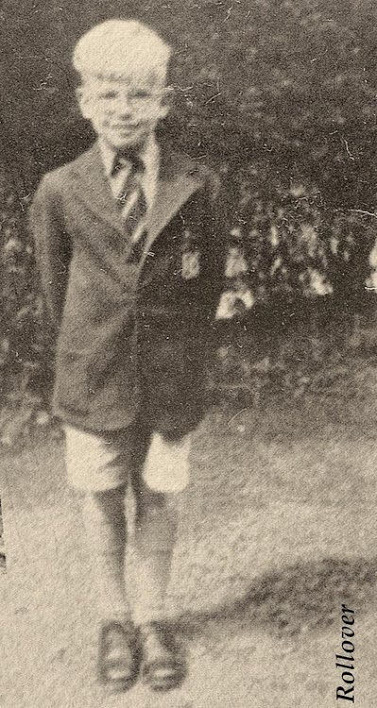
It took me about a week or two to come up with my first theory between wondering what the hell I was getting myself into and trying to decide whether I should watch Stoned. I found out very early on that Brian had developed asthma at the age of four after a bout of croup. Knowing that asthma attacks can result in death, I didn’t think it unlikely that Brian could have drowned as a result of an asthma attack. In my research, I found an article stating that chlorine mixing with organic material can trigger symptoms of asthma attacks and allergic reactions.
I knew I’d need more evidence though but given that I didn’t want to be too intrusive this early on, that would be a slow process. If there was one thing I held on to, it was my firm resolute to not fall for another murder conspiracy so soon. It didn’t end so well for me the last time.
As I was trying to piece together what exactly happened to Brian Jones, I was also beginning to find out the story of how he got to that point in the first place.
There are many reasons I have love-hate relationships with Mick Jagger and Keith Richards, and their treatment of Brian Jones is by far the biggest one.
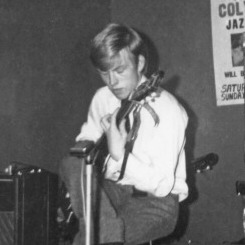

Where the story of Brian Jones’ decline really starts is at the Ealing Club on 7 April 1962. It was here that a young Mick Jagger, Keith Richards, and Dick Taylor saw Brian “Elmo Lewis” Jones take the stage for the first time. The next month, Brian put an ad in the papers for musicians to come join a band he was starting. He quickly brought together Ian Stewart, Mick Jagger, Keith Richards, Dick Taylor, and Tony Chapman. The band, which Brian dubbed “The Rollin’ Stones,” gave their first performance on 12 July 1962, though there seems to be some confusion over who was playing drums that night. Bill Wyman replaced Dick Taylor on 7 December 1962, and Charlie Watts replaced Tony Chapman on 9 January 1963.
In the early days, Brian served as the Stones’ manager. It ended up being this very thing that led to the first cracks in this fortuitous partnership.

First thing’s first, Andrew Loog Oldham came along, and in May, he became the Stones’ manager. He only really had eyes for Mick and was one of the ones who led the subsequent whispering campaign against Brian. Not helping anything was when, on 13 October 1963, the others found out that Brian had been paying himself an extra £5 ($5.58). These were expenses he deducted because he believed that should be his pay, considering he was doing much of the work at this time. (I can sort of relate; I’ve suffered through high school group projects).
On the economics side (lord knows, that’s more Mick’s thing than mine), Bill Wyman has since stated that the Stones were making £193 ($215.38) a week. Adjusting for inflation, Brian was deducting roughly £87.26 out of £3,608.53. For the Americans in the crowd, that’s roughly $114.20 out of $4,722.66, once adjusted for inflation. Granted, across the board, that’s roughly 2.5% of the band’s total income at this point. Still, even that much might matter when you’re a bunch of starving artists.
When Paul Trynka summarized why everybody was pissed in his book, Brian Jones: The Making of the Rolling Stones, he said that for Mick, it was because he was a student at the London School of Economics. Five pounds is five pounds. Meanwhile, Keith was pissed because he, like everyone else in the band, was under the impression that they were earning equal pay in this group effort.
Pro-tip: If you start a band and feel you should be paid more because of how much of the work you’re doing, please disclose this with your band and work out an arrangement that will be beneficial to everyone. Otherwise, shit gets ugly.
Brian also didn’t help his case by insisting on staying in fancier hotels than the others (he was a bit of a neat-freak and a narcissist).
Keith later said, “He had an arrangement with (Eric) Easton, that as leader of the band he was entitled to this extra payment. Everybody freaked out. That was the beginning of the decline of Brian. We said, ‘Fuck you…’”
Meanwhile, Ian Stewart (who had been ousted from the band earlier that year) stated, “When we started playing outside London, Brian said, ‘I’m the leader of the group and I think I’ll stay at the best hotel. All the rest of you can stay in a cheaper hotel.’ Of course, the rest of the Stones just laughed at him, and that was it from then on. It was all over for him as the leader. He started to isolate himself because of this attitude.”
With one little five-pound note (and an ego trip), Brian had set in motion his entire downfall.
It might seem petty to myself and plenty of other Brian Jones fans, but lord knows, I’m not Mick Jagger, Keith Richards, or Andrew Loog Oldham. Besides, I have no idea how I’ll feel about all this in five years.
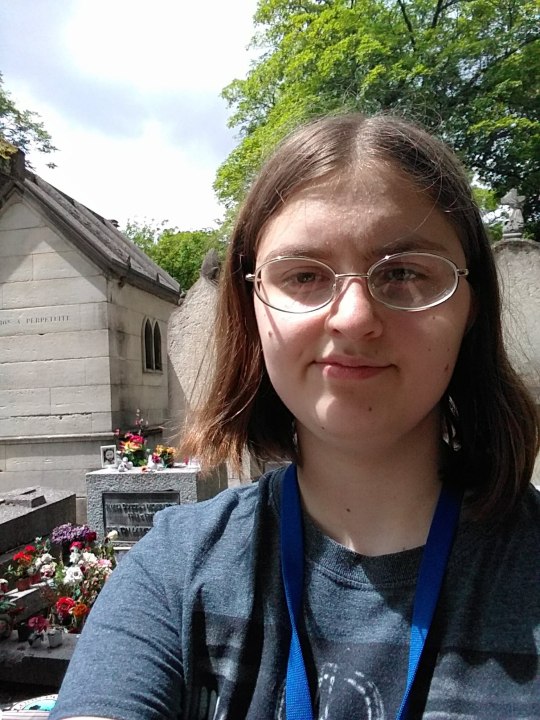
Meanwhile, I must confess that I almost did fall into that mindset of believing Brian was murdered. In June 2019, I was in Paris, on a trip across France led by my French teacher. Somewhere between trying not to lose my mind in a big city and taking awkward selfies at Jim Morrison’s grave, I, being overly chatty, started talking to one of my peers about music-related topics. I told her Brian’s entire life story as I understood it at that time, having been obsessed with him for a little over a month at that point. In my haste though, I unintentionally managed to convince her that Brian had been murdered. Despite not meaning to, I did end up entertaining the possibility, both for her and myself, for at least the rest of the night.
Besides, at the time, I was drawing blanks in trying to find hard evidence that Brian wasn’t murdered. I had one (water-logged) book saying he wasn’t, and a (shitty) movie and another book saying he was.
And then, at some point, I regained my senses, and not because of how ridiculous Brian’s death was when depicted in the movie Stoned. (For fuck’s sake, there was a shooting star in the sky at the moment of his death and he showed up as a ghost in the last five minutes). It really had everything to do with how much I regretted believing Kurt Cobain had been murdered.
I once again gathered my resolve and decided to go back on the hunt for more clues.


The second part of Brian Jones’ decline undoubtedly involves his tempestuous relationship with German-Italian actress Anita Pallenberg. The two started dating after a Rolling Stones concert in Munich on 14 September 1965 and developed a close bond, thanks in part to Brian’s ability to speak German. She gave him the confidence he needed to go against Mick and Keith and helped him become the fashion icon he is still remembered as today.
The Who’s Pete Townshend later had this to say: “We hung out a lot from about 1964 to 1966. Part of the time he was seeing Anita Pallenberg. She was a stunning creature. I mean literally stunning. It was quite hard to maintain one’s gaze. One time in Paris I remember they took some drug and were so sexually stimulated they could hardly wait for me to leave the room before starting to shag. I felt Brian was living on a higher plane of decadence than anyone I would ever meet.”
However, their relationship was also highly abusive. They would verbally and physically abuse each other. In fact, one time, Brian broke his wrist while the two were on a trip in Tangier. Though Brian said it was the result of an accident, Christopher Gibbs and Bill Wyman have both stated that it resulted from an altercation with Anita (though sources vary about whether he broke his wrist on a metal window frame or her face).
Of their relationship, Keith had this to say, “I would hear the thumping some nights, and Brian would come out with a black eye. Brian was a woman beater. But the one woman in the world you did not want to try and beat up on was Anita Pallenberg. Every time they had a fight, Brian would come out bandaged and bruised.”
youtube
I’d go so far as to say that the one good thing that came out of their relationship was the fact that Brian composed the soundtrack for her movie Mord Und Totschlag (A Degree of Murder).
As I’ve previously written about, when Mick and Keith were charged with drug possession in February 1967, lawyers told the Glimmer Triplets (Mick, Keith, and Brian) that since they were the most visible of the Stones, they should leave the country. So, Brian and Anita left Britain, heading for Morocco. However, Brian was already in no condition to travel, and he fell ill with pneumonia in Toulouse. He ended up spending a few days there (including his 25th birthday), while Keith and Anita met up in Tangier. There, she started an affair with Keith behind Brian’s back (Keith even confirmed in his autobiography that she made the first move).
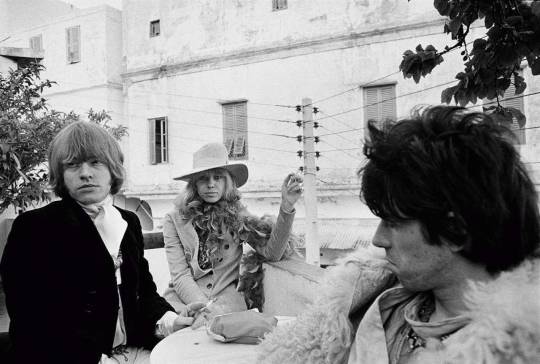
When Brian finally arrived, he could tell that there was something going on between Keith and Anita. Keith was apparently shy around girls at this stage in his life but was more confident around Anita. Meanwhile, Anita was now a bit more open around Keith. Not much is certain about what happened next. What is known is that Brian paid for the services of two prostitutes and that there was an incident between him and Anita that night. Keith said that he threw food at her and humiliated her. Bill claimed that he beat her to the point where she was scared for her life. The less said about Stoned, the better.
Regardless, whatever Brian’s actions really were, it was over between him and Anita. Keith convinced her that if they didn’t get the hell out of there, Brian might try and kill her. The next day, Mick, Keith, and Anita fled Morocco, leaving Brian stranded for the next two days.
Brian’s father later blamed his son’s downward spiral on Anita breaking his heart. Others, such as Linda Lawrence, suggest that it was Mick and Keith’s betrayal that hurt him far more than Anita’s.

In either case, he never really forgave Keith. Beyond that, his drug and alcohol consumption only worsened.
This part of the Stones’ history is… tricky. Of course, I can’t condone Brian for his behaviour, but Keith, and especially Anita weren’t entirely in the right in this situation. Ultimately, Keith and Anita stayed together until 1980 and had three children (one of whom unfortunately died in infancy). Besides, I understand Keith’s actions the most out of everyone, given that he had a noble intent in getting Anita away from Brian’s increasingly toxic behaviour. Of course, it’s also important to note that Brian and Anita were 25 and 24 respectively at the time of this incident, and beyond that, they were young and impulsive, with unfortunately predictable results, given that they both could be volatile.
I may have an infatuation with Brian, but sometimes, something’s got to give.

Fifty-two years after that clusterfuck, I was continuing my research into the life of L. B. H. Jones as the fiftieth anniversary of his death came and went. A week or two later, I decided, despite some reservations, to get Bill Wyman’s book, Stone Alone.
Say what you will about Bill (I know at some point I’ll be commenting about the travesty that was his relationship with Mandy Smith), but I figured that if I wanted to know about the early Rolling Stones, he’d be one of my best sources. At the very least, he’s the only one who’s given Brian any sort of credit for his accomplishments instead of solely focusing on his failures like Keith tends to do. As I was flipping through random pages, I learned that Bill had written about one of Brian’s many illegitimate children. He called her “Carol,” for the sake of anonymity, and in it, he discussed the matter of her being diagnosed with temporal lobe epilepsy. She and Bill even applied some of her symptoms to things Bill observed when he was with Brian. In that one instant, what happened to Brian the night he drowned seemed to make perfect sense.
One of the things that had made putting the clues together so difficult from the very start was that Brian had punctate haemorrhages (tiny bleeds normally found in shaken baby syndrome) in his brain, which indicated that he’d been thrashing around quite a bit in his final moments.
Temporal lobe epilepsy can’t be cured, but it is manageable to a degree with medications. Brian, however, was never diagnosed, which is why we can’t be certain that he had epilepsy. There is no doubt in my mind that if Brian did have epilepsy, it would’ve gotten worse over time, given that Brian received no treatment. Carol speculated that Brian likely chalked up many of his symptoms to being hungover. Even then, he might not have realized that something was happening with his brain.

While I was typing up my theories though, I remembered that I’d found his toxicology report not long beforehand. As I read it, I found out that the drug that was in his system was likely Mandrax, which he had been prescribed in the days before he died. When I looked up Mandrax, I discovered that it was a brand name for Quaaludes. It can cause mental confusion, ataxia, seizures, and impaired decision-making, among other negative side-effects. The impaired judgment would explain why Brian decided it’d be a great idea to go swimming after he’d had sleeping pills and alcohol…
I still didn’t consider my work done, but this was the closest I’d come to having answers yet.

Speaking of Brian and drug abuse, the third key to understanding what happened to Brian, is to look at his two drug convictions.
However, I already talked about this (quite recently too), so I’ll try and keep this section brief.

As Mick and Keith were formally charged with drug possession on 10 May 1967, Brian found his home being raided by police. Although he’d been tipped off about their arrival, they still managed to find a handbag with cannabis in it, as well as methamphetamines and cocaine. It could be argued that the evidence was planted, but there is no way to prove this. In court, Brian confessed to doing cannabis but denied doing anything stronger (even though there’s pictures of him tripping on LSD early in 1967). The Stones’ new manager, Allen Klein, told him to stay away from the other Stones. However, this had the effect of further isolating Brian when he needed his bandmates the most.

On 30 October 1967, Brian was sentenced to three months in prison for cannabis possession and another nine months for allowing cannabis to be smoked in his home. He was additionally fined. After a rough night in prison, he was released the next day, awaiting appeal, though he was left shaken by that experience.

On 12 December, Brian went to appeals court, where his psychologist argued that Brian would become suicidal if he went to prison. Brian was sentenced to three years’ probation and ordered by the courts to seek professional help.
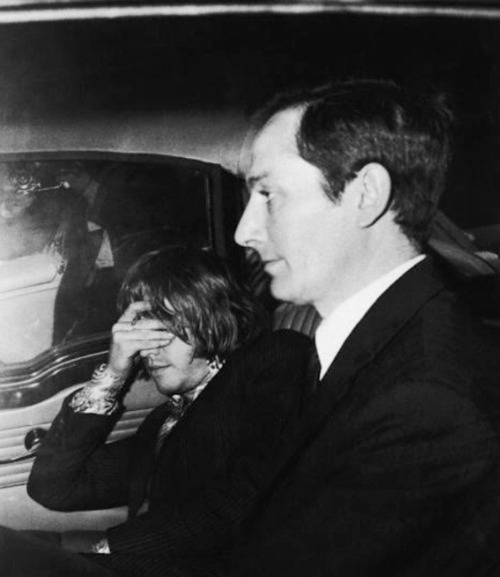
Lord knows, at this point, Brian might have been making an honest-to-God effort to get off drugs, but on 21 May 1968, police raided his house again. This time, they found cannabis hidden away in a ball of wool in the process. This usually inspires more impassioned arguments from Brian Jones fans that the evidence was planted. Brian himself said that he would swear until the day he died that he didn’t commit this second offense. Because he was still on probation at the time of this second arrest, he was facing a long jail sentence if found guilty.

On 26 September, Brian was found guilty of drug possession for the second time. However, the same judge who sentenced him to a year in prison the first time took pity on him. Instead, he fined Brian and gave him a stern warning to not show up in court again.
As you can see with the attached pictures though, the trials only helped speed up Brian’s downward spiral, and he shut down mentally.
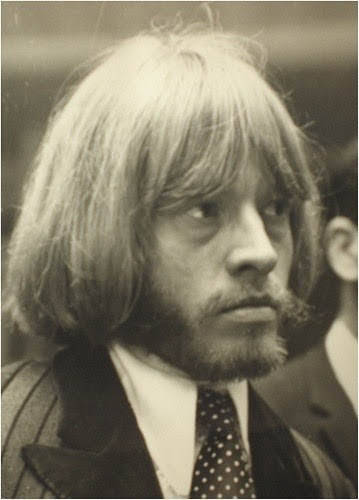
Honestly, I think the trials are a large part of the reason Brian went downhill as fast as he did.

Meanwhile, back in the present day, it was September now, and I was starting to get into the swing of being a full-time college student. While I was procrastinating, as usual, I was messing about on Google and I happened upon Brian’s autopsy report. Fact about me: this was far from my first time reading either autopsy reports or death certificates, so I decided to give it a look. After all, I could understand quite a bit of the medical jargon, which I blame on the fact that I loved reading medical books in elementary school. Couldn’t hurt, right?
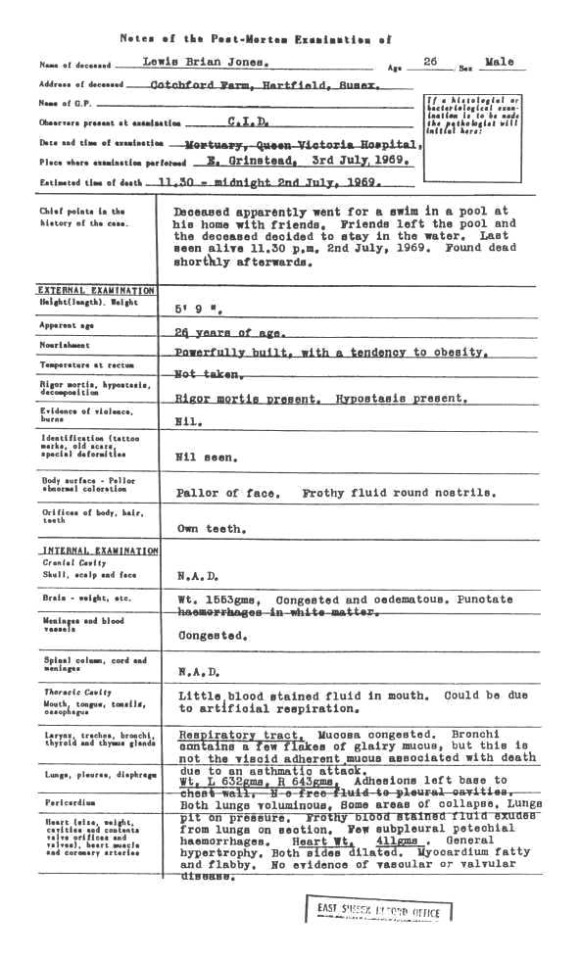

Was the report perfunctory? Yes. Were there mistakes? A few that stood out, such as Brian’s height being given as 5′9″ when he was 5′6″, and his age being listed as twenty-six as opposed to twenty-seven.
However, that report did reinforce my most recent conclusions that Brian had overdosed on sleeping pills, which was exacerbated by alcohol.
I knew now that Mandrax had once been prescribed to treat anxiety and insomnia, which Brian likely suffered from following the stress of two drug trials that both resulted in convictions. This was also a time before doctors realized the addictive properties of Quaaludes. For all I know, Brian might not have been keeping the best track of how many pills he was taking (which is also how Keith Moon died).
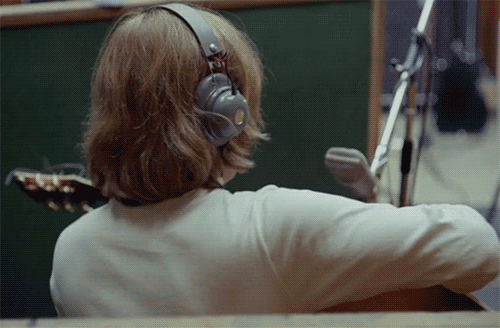
Going back to the long, sordid story of Brian’s collapse, the fourth major reason he found himself being kicked out of the band he founded was that he stopped contributing to the Stones’ music.
In the documentary Crossfire Hurricane, Mick stated, “You certainly didn’t know if he was going to turn up and what state he was going to be in and then, what he was going to be able to do in that state. What job could you give him? And then, one time, when we sat around, on the floor, we played, in a circle, playing “No Expectations”. And he picked the guitar and played a very pretty line on it which you can hear on the record. And that was the last thing I remember him doing that was Brian. Or, the Brian that could contribute something very pretty and sensitive and it made the record sound wonderful.”
youtube
Some people have compared Brian to someone who wants to quit but doesn’t want a confrontation (Brian, believe it or not, wasn’t exactly keen on confrontation). Instead, he puts in the smallest effort he can, if that. In fact, Brian had wanted to leave in 1967, but Mick convinced him to stay.
Perhaps Brian’s fate might have been different if he’d gone with his gut in 1967.
Brian still contributed to much of Beggars Banquet. By 1969 though, it seems as if he’d completely given up on the band he’d founded. He stopped showing up to the studio, and if he did come, he’d be too intoxicated to play. In fact, there were points where Mick and Keith would turn off his amp, if not tell him to just go home. It got to the point where he (barely) appears on two songs on Let It Bleed: “Midnight Rambler” and “You’ve Got the Silver.”
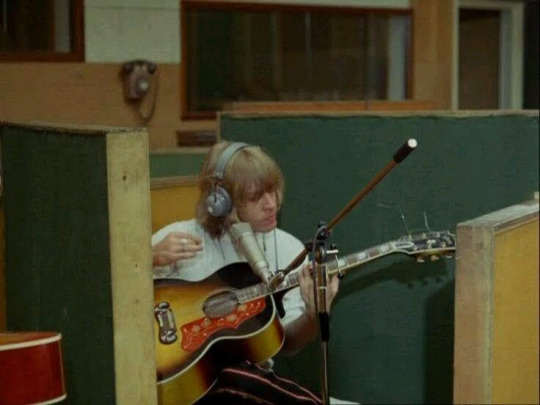
Frequent Stones collaborator Jack Nitzsche later said “Brian came up to me, looking pretty shaky, and asked me what I thought he should do- he didn’t know where he fit[ted] in. I told him to just pick up a guitar and start playing. Then he walked over to Mick and asked, ‘What should I play?’ Mick told him, ‘You’re a member of the band, Brian, play whatever you want.’ So he played something, but Mick stopped him and said, ‘No, Brian, not that- that’s no good.’ So Brian asked him again what to play and Mick told him again to play whatever he wanted. So Brian played something else, but Mick cut him off again- ‘No, that’s no good either, Brian.’”

Marianne Faithfull, Mick’s girlfriend at the time, told a friend that Brian had sent Mick several letters over a period of several weeks while Mick was away. One that she’d opened said “Please let me come back in. I’ll play bongos, anything, but please let me come back in.”
…I need a moment to recollect myself.

Some fifty years later, I was still trying to make it through my first semester of college. I got myself a book about the 27 Club, figuring there might be something that would aid me in my research. There, I learned that, reportedly, Brian had not only been taking Mandrax, but also Piriton (hay fever medication), black bombers (which had been prescribed to him a mere ten days before he died), and Valium. That’s on top of an inhaler that would later be found to cause heart palpitations.
A couple of months later, I decided to look up the side-effects of every drug that Brian had ever taken, be it proven fact or allegation. That part of my research isn’t quite finished yet, but what I’ve found with the five medications that Brian was taking around the time of his death proved to be particularly shocking.
For the sake of brevity, I can’t list every side-effect. What I did notice is that some included side-effects of tachycardia/bradycardia, confusion, loss of coordination, impaired decision making, hyperactivity, seizures, and stomach problems. Some, like the uncoordinated behaviour, were noted by those who were there, such as Janet Lawson, who realized that Brian had taken sleeping pills that night, based on him muttering that he’d taken “sleepers”. Others could be a no-brainer, given that Brian had an enlarged heart and liver, in addition to suffering from bronchial troubles and pleurisy.
My immediate thought was, “Jesus, Brian, what the hell were you doing to yourself?”

And now for the final part of Brian’s story: the last twenty-five days of his life.
The Stones wanted to go on tour again, this being their first in two years. Due to Brian’s convictions, Stones management discovered that he probably wouldn’t be able to receive a work visa in the U.S. On 8 June 1969, Mick and Keith drove down to Cotchford Farm to tell Brian that he was fired. They brought Charlie along in case Brian decided to put up a fight. However, Brian agreed to back out gracefully, possibly knowing that he’d burned too many bridges at this point. The next day, Brian released a statement, which painted the decision to leave as being his own. He capped it off with “We had a friendly meeting and agreed that an amicable termination, temporary or permanent, was the only answer. The only solution was to go our separate ways, but we shall still remain friends. I love those fellows.”
As I’ve said though, how Brian truly felt about this turn of events will forever remain a mystery.
In the days before he died, it has been suggested by those close to him that Brian was planning on starting another band. Some believe he was going to bring in Jimi Hendrix and John Lennon. Jimi’s camp has since denied that Brian ever approached Jimi. There are also lingering questions regarding whether Brian had given up hard drugs or if he was still taking them. I doubt the latter, considering the well-documented stress of the drug trials.

The picture above was taken nine days before Brian died. Honestly, I do believe there was still some hope for Brian (I can even see it in his eyes). Whether he would’ve recovered or not and whether he’d still be alive today will forever remain up to conjecture, as that’s another possibility that followed Brian to the grave.
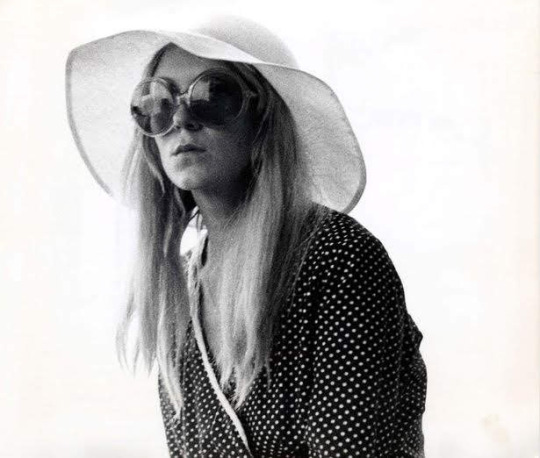
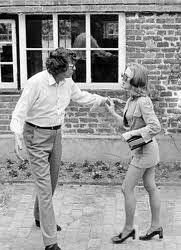
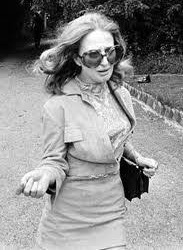
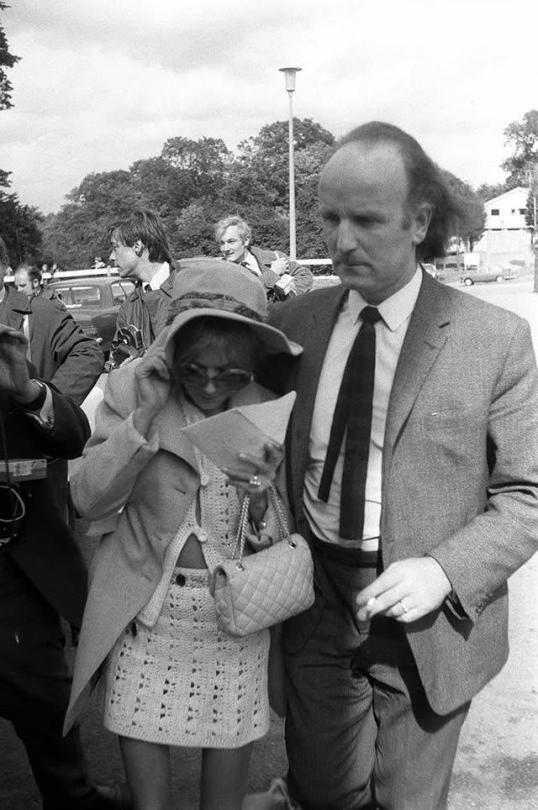
Wednesday, 2 July 1969 was host to hot, muggy weather that exacerbated Brian’s asthma. He spent his last day alive with at least three people: Anna Wohlin, his 22-year-old, Swedish girlfriend, Janet Lawson, a registered nurse who was dating Stones minder Tom Keylock, and Frank Thorogood, a 43-year-old builder who’d been doing work on Brian’s property at the time.
Details of Brian’s final day are sketchy, and there are some disagreements over what exactly the people involved did throughout the day. For example, there are disagreements about whether they watched television or not. Some would argue that this is clear evidence that Brian was murdered. I would posit that three of the four parties involved had been drinking. Even if everyone was sober, in a situation such as this, human memory can be extremely unreliable. For example, hundreds of witnesses were interviewed on the night Abraham Lincoln was assassinated, but no two accounts are alike. What we know had to be stitched together from witness accounts in which everyone claimed to have seen or heard something different.
What seems to be the most agreed-upon version of Brian’s death is that he decided to go swimming. Anna was reluctant and had to be persuaded to join in. Janet, the only sober person among the group, decided against swimming, most likely to keep an eye out for everyone else. Janet said in her witness report (recorded on the morning of July 3, 1969) that she strongly felt that Frank and Brian were in no condition to swim. She also recalled that Brian had great difficulty in standing on the diving board, being helped not-so-successfully by Frank. Even after that, his movements in the water seemed sluggish.
I don’t know, but if that were me, I would’ve called emergency services right there and then.
According to Janet, Anna was the first to return to the house, followed by Frank about ten minutes later. When Janet next went out to check on Brian sometime around midnight, she found him face-down in the deep end, and “immediately sensed the worst.”

She ran back to the house to get Frank and Anna, and with their help, got Brian out of the pool. She immediately began resuscitative efforts, despite knowing Brian was already dead. Anna later claimed that she felt Brian’s hand briefly grip hers. However, when paramedics arrived, they pronounced Brian dead in the early morning hours of 3 July 1969.
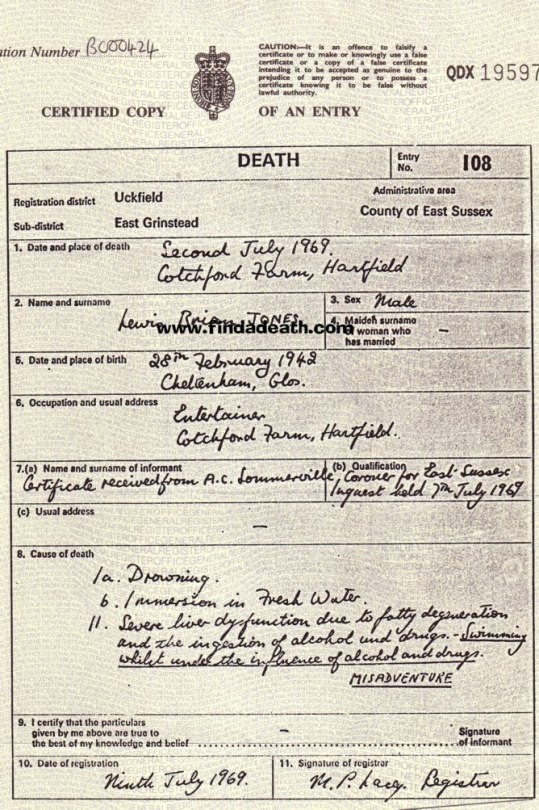
Brian’s official cause of death was given as drowning by immersion in fresh water, partly as a result of liver damage and the ingestion of drugs and alcohol. To be precise, 1,720 micro-gms of an “amphetamine-like substance” and the alcohol equivalent of three-and-a-half pints of beer were found in Brian’s system.
In short, it was death by misadventure.
As seems to be the case when a young celebrity dies under tragic circumstances, conspiracy theories have since risen regarding Brian’s death. The following list is taken from Paul Trynka’s book. For the sake of brevity (such as it is), some of these will be combined into one section.
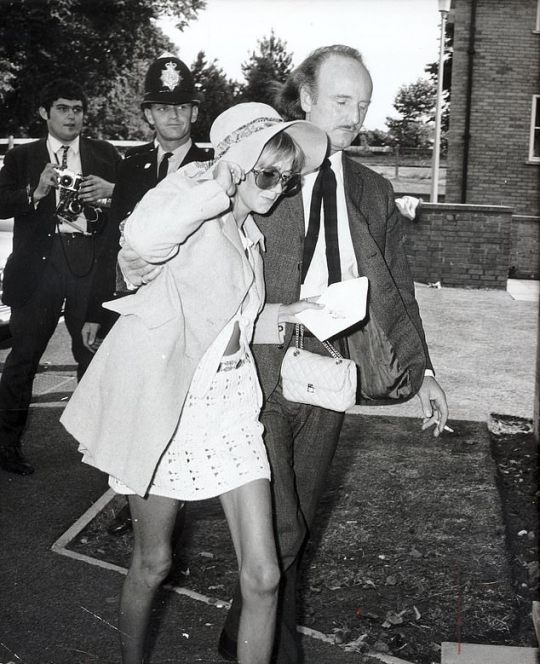
1. The most predominant of these theories states that Frank Thorogood drowned Brian. Whether it was second-degree murder or manslaughter as a result of rough horseplay will usually vary between sources. Brian reportedly asked Janet to get his inhaler shortly before his death. The story then goes on to state that Frank drowned Brian and participated little in the efforts to save Brian’s life. It should be noted that Janet did state in her original testimony that she’d asked him to call emergency services.
The main reason people will give about why they believe that Brian was murdered is that Tom Keylock claimed to have heard Frank confess on his deathbed to the murder. However, Frank’s daughter, Jan Bell, has denied that such an exchange could have happened. There was never a point where Keylock had spent any time alone with her father. Furthermore, he’d only been admitted with a respiratory problem, and thus could not have known that he was on his deathbed. She also claimed that on the morning of Brian’s death, Frank saw an argument between Mick, Keith, and Brian over the name “Rolling Stones.” During the fight, Keith allegedly pulled a knife on Brian. If this did happen, it was likely earlier in the year.
In addition, Janet and Anna have since claimed that Brian was murdered. Janet later claimed that much of her original testimony was suggested to her by investigating officers and that Tom told her to hide the fact that she was his girlfriend. Anna claimed that she was spirited back to Sweden in the immediate aftermath of Brian’s death, where she allegedly miscarried Brian’s child. One of Anna’s friends later said that her belief that Brian had been murdered was a recent development. It’s also notable that neither witness came forward until after Frank died. Many of Anna’s recollections about Brian, such as him being focused on music are also contradicted by others who were close to Brian at the time.
Keith later said, “I knew Frank Thorogood, who made a ‘deathbed confession’ that he’d killed Brian Jones by drowning him in the swimming pool, where Brian’s body was found some minutes after other people had seen him alive. But I’m always wary of deathbed confessions because the only person there is the person he’s supposed to have said it to, some uncle, daughter, or whatever. ‘On his deathbed he said he killed Brian.’ Whether he did or not I don’t know. Brian had bad asthma and he was taking Quaaludes and Tuinals, which are not the best things to dive under water on. Very easy to choke on that stuff. He was heavily sedated. He had a high tolerance for drugs, I’ll give him that. But weigh that against the coroner’s report, which showed that he was suffering from pleurisy, an enlarged heart, and a diseased liver. Still, I can imagine the scenario of Brian being so obnoxious to Thorogood and the building crew he had working on Brian’s house that they were just pissing around with him. He went under and didn’t come up. But when somebody says, ‘I did Brian,’ at the very most I’d put it down to manslaughter. All right, you may have pushed him under, but you weren’t there to murder him. He pissed off the builders, whining son of a bitch. It wouldn’t have mattered if the builders were there or not, he was at that point in his life when there wasn’t any.”
(You’re telling me he can apologize for telling Mick to get a vasectomy, but not for even a fraction of the shit he’s said about Brian?)
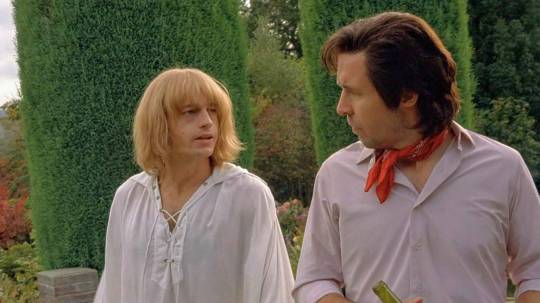
In 2005, this version of events was turned into the appalling movie Stoned, which featured Tom Keylock as an adviser and was based on claims made by Janet Lawson and Anna Wohlin. The director, Stephen Wooley, claimed to have researched the material for this story over a period of ten years. Really, it feels less like ten years of research, and more like one week. From what I could tell, it did seem that Brian’s death was manslaughter, but honestly, it was too confusing. Frank seemed damn determined to drown Brian in that moment. The movie (quite literally) drowned on arrival.
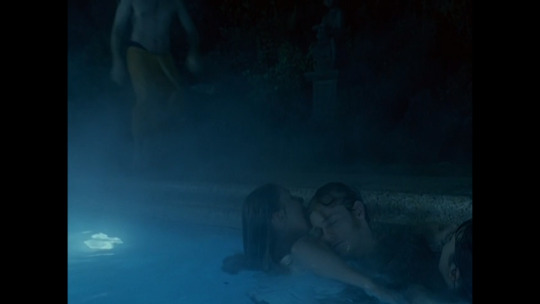
2. In 1983, Nicholas Fitzgerald wrote Brian Jones: The Inside Story of a Rolling Stone. In it, he claimed to have been a close friend of Brian Jones (his cousin, Tara Browne, actually was a close friend of Brian’s). Not only that, but he claimed to have seen Brian’s “murder.” He claimed that he and 19-year-old Richard Cadbury (who passed away before the story came out) visited Brian at Cotchford Farm the day he died. Allegedly, Brian told Fitzgerald all about his plans to start up a supergroup with John Lennon and Jimi Hendrix, saying “Don’t say anything… it could be dangerous!”
(As keen as I am about the idea of John Lennon, Jimi Hendrix, and Brian Jones being in the same band, you can probably tell that I think this story is a load of bullshit.)
After Fitzgerald and his friend visited a pub, they returned to Cotchford Farm at about 11:15 PM, leaving their car some distance from the house. (Keep in mind, the coroner said that Brian died somewhere between 11:30 PM and 12:00 AM). There, he and his friend saw three men holding Brian under the water, whilst two other people stood by. Suddenly, a man, likely Keylock, jumped out of the bushes and told Fitzgerald to scram, lest he be next.
He refused to give a formal statement to the police. What I don’t think the dumb fuck was counting on was that police would investigate his ass, considering that withholding information could’ve resulted in him being charged with being an accessory to murder after the fact. The police determined that the evidence Fitzgerald gave was “bizarre, full of unverifiable claims that, he, too, had escaped murder attempts, that Cadbury might have been involved with the murderers, and that Cadbury, too, had died ‘in mysterious circumstances”. Detective Chief Superintendent J. F. Reece summarized it best when he said that Fitzgerald was a “Walter Mitty type person” and that he’d come up with the allegations to promote his book. In fact, the book itself had even more ludicrous allegations, such as how Tom Keylock had overseen the whole thing. It got to the point where Eddie Kramer called the story “silly.” John Lennon, meanwhile, believed that Brian was another victim of the drugs scene, and even dreaded him coming on the phone (another reason I don’t believe the supergroup was in the cards for Brian’s future, regardless). Also, Fitzgerald mostly relied on the testimony of those who had already passed away, such as Suki Potier, one of Brian’s girlfriends, who died in a car crash along with her husband in 1981. One of the few living witnesses Fitzgerald claimed to have run into, James Phelge, denied ever having met him.
Also, pro-tip, if you’re going to claim to have been a close friend of someone you’re claiming was murdered, don’t sell your story to the tabloid that got him busted for drug possession. Just saying.
3. In 1990, A. E. Hotchner published Blown Away: The Rolling Stones and the Death of the Sixties. In it, he claimed that Brian’s childhood friend, Dick Hattrell, and a random Cockney named "Marty” had knowledge that Brian was murdered. He claimed that Rich (sounds better to me than Dick) visited Brian shortly before he died and became worried about him. Later, he bumped into someone who claimed to have witnessed Brian’s murder. Marty claimed to have witnessed the murder, claiming that two other women were there, including Linda Lawrence (mother of one of Brian’s sons) who was spirited out of the country following Brian’s death.
In reality, she last saw Brian in 1968.
Similarly, Hattrell has since stated that the story was nonsense; he never visited Brian at Cotchford, and he never said Brian was murdered. Marty has since kept his mouth shut.
Really, it just doesn’t hold up when closely scrutinized.
4. David Gibson claimed to the Brighton Evening Argus that, while he was fitting carpets at Brian’s home, Brian and Anna were absent throughout the better part of the day. When they returned later in the evening, Brian begged Gibson not to leave. Gibson, meanwhile, believed Brian had been murdered and that Tom Keylock was responsible. Some, like Sam Cutler, claim that Gibson saw Princess Margaret at Cotchford Farm, which has led to speculation that Brian was killed to protect her reputation. Gibson never went to the police, and probably believed that he’d been subject to threats and murder attempts. However, aside from Brian’s paranoia and belief that someone was out to get him, Gibson’s story doesn’t line up with many of the other conspiracy theories.
5. Geoffrey Giuliano in his 1994 book Paint It Black claimed that a man named “Joe” said that he’d held Brian’s head under the water for shits and giggles (not something one would normally do for shits and giggles). The thing is though, Giuliano’s book largely recycled content from previous books on the subject, and beyond that, made elementary mistakes, such as claiming that Frank had fled the scene, when in reality, he was there when police officer Albert Evans arrived at about 12:10 AM. It was later found that the tape he’d sourced some of this information from was a fake, made for American radio programmes in New York.
6. Given that Tom Keylock was a bit of a dishonest/disliked character in life, it should come as no surprise that some of the theories focus on him too. In 2009, Sam Cutler claimed that after Brian’s death, Allen Klein (himself a sleazeball) hired some PI’s to investigate Brian’s death and that they’d discovered that Tom was responsible. While Tom did try to pin the blame on Frank and told Janet to conceal her relationship with him, and it is known that he apparently stole some of Brian’s belongings after he died, that does not make one a murderer. It’ll certainly make him a slimeball, but that doesn’t mean he’s a murderer. Meanwhile, in 2013, Cutler claimed confusion as to whether the Klein report even existed. I think at this point, it’s safe to call it a hoax.
In addition, while it is more likely that Tom would have been the murderer instead of Frank, he does have a rather rock-solid alibi in that he was at Olympic Studios and was the one who received the call that Brian had died. Really, any theories that try to say he masterminded a huge plot to have Brian killed and make it appear as an accident tend to raise more questions than it answers.
Let’s all make no mistake though, the police did jump to conclusions rather quickly, there are several obvious mistakes in the autopsy findings, and not to mention, police failed to control the area, which is likely how Tom was able to steal Brian’s belongings and possibly have some destroyed.
Meanwhile, I myself believe that Brian’s death was accidental. Likely, it was the result of a cocktail of prescription medications, alcohol consumption, maybe a side-effect or two resulting from that, and possibly even heart failure or liver disease. Perhaps Brian fainted (which, I honestly hope for, given how painful it is to drown), and with no one around to notice his plight, he quietly slipped away.
I know there’s no way to prove this, given that the police don’t have a good reason to dig up Brian’s bones and it’s probably far too late for a second toxicology report, but given the available evidence I’ve been able to find, I believe this is the most likely version of events.
Truly, a sad ending for a man, who didn’t even have a chance to get back on his feet before fate (and a lifetime of drug/alcohol abuse) intervened.

Whenever I read about Brian’s life story, I always find myself interested by the mistakes, intrigue, and betrayal that seemed to plague Brian’s life from the outset. There are a multitude of what-ifs that honestly make this tale haunting, such as what might’ve happened had Mick and Keith not bullied Brian so severely. There’s also what might have happened if both the Stones and the authorities had better understood the effects of drug use and had the resources and compassion to better deal with Brian’s situation. Most hauntingly, there’s the question of what might’ve happened had someone been near Brian in his final moments and had the opportunity to save him.
I think the biggest reason I keep coming back to his story is that his life as a whole was very conflicting. It honestly inspires both condemnation and sympathy/pity, even in me.
Even if Mick and Keith would rather forget that Brian was ever a part of their band, it is my honest belief that people will continue to discover Brian Jones, whether it be through the 27 Club or through some other means, and I hope that they take the time to learn his story.
youtube
Sources/Further Reading: https://www.drugs.com/illicit/quaaludes.html https://asthma.net/living/swimming-pools-triggers/ https://www.drugs.com/sfx/ergotamine-side-effects.html https://www.drugs.com/sfx/valium-side-effects.html https://www.drugs.com/sfx/amphetamine-side-effects.html https://www.drugs.com/sfx/chlorpheniramine-side-effects.html Stone Alone by Bill Wyman Brian Jones: The Making of the Rolling Stones by Paul Trynka Brian Jones: The Untold Life and Mysterious Death of a Rock Legend by Laura Jackson https://clearcomfort.com/why-asthma-allergy-sufferers-should-avoid-chlorine-pools/ http://timeisonourside.com/chron1967.html http://timeisonourside.com/chron1969.html http://www.timeisonourside.com/chron1963.html http://www.timeisonourside.com/chron1962.html https://www.inflationtool.com/british-pound/1963-to-present-value?amount=5 https://people.com/music/anita-pallenberg-rolling-stones-keith-richards-brian-jones-love-triangle/ https://www.rollingstone.com/culture/culture-lists/the-27-club-a-brief-history-17853/ https://ultimateclassicrock.com/brian-jones-found-dead/ https://www.denofgeek.com/us/culture/music/281978/the-rolling-stones-and-the-mystery-of-brian-jones-death https://www.rollingstone.com/music/music-news/brian-jones-sympathy-for-the-devil-182761/ https://www.mojo4music.com/articles/15989/brian-jones-it-was-murder https://ultimateclassicrock.com/brian-jones-murdered/ https://www.udiscovermusic.com/stories/just-why-was-brian-jones-so-important-to-the-rolling-stones/ https://www.rollingstone.com/music/music-news/obituary-brian-jones-189861/ https://www.oxfordtreatment.com/prescription-drug-abuse/tuinal/
#brian jones#the rolling stones#mick jagger#keith richards#charlie watts#bill wyman#ian stewart#this got long#but i felt i should explain all of this in one go#rock and roll#cw: death#cw: drugs#cw: domestic abuse#cw: drowning#man brian's life was a bit of a clusterfuck
12 notes
·
View notes
Text
Double Take #2: “The Other Exchange Student.”
As I mentioned in my last post, I've started a new series of analysis posts that I am calling Double Take. Each of these posts will focus on an episode from the first season of Star vs. the Forces of Evil, usually a less-popular episode, and discuss the surprising complexity that some of those early episodes offer.
The season one episodes that I plan on talking about act, I believe, as a kind of "primer" for the audience -- that is, an instruction book on how to view future episodes; in other words, these episodes subtly introduce complicated ideas in order to prepare the audience for the later return of these ideas in even more complex forms. One such episode that falls into this category is "The Other Exchange Student."
Why This Episode?
Like "Lobster Claws," "The Other Exchange Student" is a lesser-liked episode that many rank near or at the bottom of their list of favorites. I, too, ranked it near the bottom of my favorite episodes. Yet on repeat viewings, I began to realize that there is something very peculiar about this episode -- something that, to my knowledge, no one has really remarked on.
In this Double Take, I'll discuss how Star's paranoia in "The Other Exchange Student" is -- despite being played for laughs -- actually quite reasonable. I'll also connect the lying and conspiracy we see in this episode to later episodes and explain the realizations I think the episode wants us to make.
Starspicious
First things first: Star is absolutely correct to be suspicious of Gustav. Though it's Star's jealousy which prompts her to be skeptical of Gustav in the first place, her belief that something is amiss is eventually confirmed by Gustav himself when he breaks down and reveals that he is, in reality, a boy named Charlie Booth.

Yet there's something peculiar about Gustav's confession: he never explains why he's measuring the Diazes in their sleep.


Gustav's inability to explain his extraordinarily suspicious behavior casts immediate doubt on all of his previous explanations -- raising the possibility that he's simply lying to Star about the rest of his actions.
Now where have we seen someone rattle off plausible explanations in response to a list of suspicious behaviors before?

Oh, right.
Webs of Deceit
I've written extensively about the (quite frankly) pretty incredible number of lies being told in season two (especially in the finale) by Ludo, Glossaryck, Moon, and Star. What's more, many of these lies seem to have fooled most viewers. Yet all the way back in “The Other Exchange Student,” we have in Gustav some early exposure to a practiced liar and social chameleon whose motives are unclear.
The show, I think, wants us to draw a parallel between Gustav's behavior and that of later characters -- particularly Ludo and Toffee. In fact, this might be why "The Other Exchange Student" is paired with "Monster Arm." I firmly believe that each pair of episodes is connected for some reason -- and the reason behind the pairing of "Monster Arm" and "The Other Exchange Student" is that they both in some way precede Toffee and Ludo's relationship. If you are skeptical, consider this: what is Ludo's wand if not a literal monster arm? And what is Toffee if not (quite literally) part of Ludo now?
But remember that Gustav isn't the only one who lies in "The Other Exchange Student"; in order to keep them happy, Star lies to the Diazes about what she's learned. Does that sound familiar? Star admits in "Starcrushed" that she's been lying to herself and to Marco about her feelings for him -- something she did in order to maintain their friendship.

Let's be honest for a moment: Gustav is no anomaly. When you really think about it, Star vs. the Forces of Evil is absolutely chock-full of shady characters:
Star, who is described -- in glowing terms, no less -- as a literal criminal.
Glossaryck, who (I argue) is one of the biggest liars of them all.
Pony Head, who lies and steals constantly.
River, who lies to Moon and sneaks away to fight monsters.
Moon, who teaches Star that the truth is dangerous.
Rhombulus, who makes a deal with Star to hide things from the commission.
Buff Frog, who used to torture people professionally.
Janna, who is just shady as all hell.
Tom, who is a psycho stalker.
StarFan13, who constantly stalks Star.
Sensei, who really shouldn't be running a business.
Oskar, who lives in his car, drops out of school, and has a record.
Roy, who fleeces people for money and sells drugs to kids.
Brigid, who steals hair (for good purposes, granted).
Lydia, who puts up a fake ad about a dog and stalks Star.
... And that list doesn't even include the "bad guys." (Sorry about getting off-track, but it just hit me how incredibly weird it is to have so many shady characters -- in a Disney cartoon, no less.)
But beyond specific comparisons, I think "The Other Exchange Student" wants to covey some broad messages to the audience as well: it wants us, the audience, to start thinking about the things that characters say; it's trying to teach us not to trust characters when they say things, to be skeptical, to make our own judgements, and to remember what really happened instead of letting characters feed us misinformation.
In short -- and this may be a bitter pill to swallow -- "The Other Exchange Student" is just a warm-up. As the series progresses, the lies will get subtler, more complicated, and harder to detect, just as they do in "Starcrushed." If that seems a little paranoid to you -- well, maybe you should be a little paranoid.
Star vs. the Forces of Evil and Other Conspiracy Theories
When we first see Star's wall of conspiracy in "The Other Exchange Student," it seems fairly obvious that we, the audience, are intended to react as Marco does and think that Star has gone insane. Yet by the end of the episode, we know the truth: that Gustav really isn't who he says he is -- and in fact might be lying about everything altogether.


This, by the way, isn't the last time we see Star's suspicions of someone be dismissed only to later be proven as correct the whole time (see "Trickstar").
But what are the implications of the fact that Star ends up being correct about Gustav?
Well, the meaning seems fairly simple to me: there are odd connections in the show that form a conspiracy -- or plot, if you will -- which points to something bigger. And "The Other Exchange Student" is the show's way of telling us to pursue those connections. How does it tell us that? By revealing that Star isn't wrong.
I truly cannot emphasize this enough: Star isn't wrong in "The Other Exchange Student." We never discover what Gustav is really plotting, and everything that he says to Star may be a lie. For all we know, he might have actually been planning to eat the Diazes the whole time. We simply never learn the real truth behind his origins or motives.

Speaking of conspiracy theories -- many of you scoffed when I brought out some (fairly convincing, in my opinion) evidence that not only was Starbruary's episode release structure based on a sonnet, but that those episodes also reference Indiana Jones and the Last Crusade.
Scoff if you like. Yet, to this day, no one has offered any better explanations as to why, for instance, "The Bounce Lounge" and "The Hard Way" are, almost shot-for-shot, compositionally alike. (Seriously -- play both episodes at the same time. It's uncanny.) I explain the similarity as them being connected through the sonnet's structure; if you have a better explanation, then please, by all means, provide it.
Furthermore, Lekmet -- as noted in my post on the Holy Grail -- is almost certainly based on Baphomet, who is connected to the Knights Templar, and I'd be hard-pressed to name any other group whose mere mention conjures up as many images of shadowy global conspiracies, hidden treasures, and murky, blood-soaked legends as the Knights Templar's does.
And, as you may recall, I finally linked the Holy Grail references to what I believe is a literal Holy Grail in the series -- in the form of Lekmet's horn, no less. If that's not a conspiracy theory, then I don't know what is! Yet I didn't conjure this out of thin air. I watched the series and wrote about it. The evidence is all right there; anyone can see it for themselves -- just as Marco might have seen in “The Other Exchange Student” if he had been willing to hear Star out.
And speaking further of conspiracy theories -- it amuses me to no end to hear people talk about how much time they spent examining the chalkboard in "Mathmagic." Even people with degrees in mathematics couldn't figure out what it means. I think that's just a case of missing the forest for trees -- but I can't blame them for trying. After all, the music in that final scene sounds suspiciously like the opening theme from Gravity Falls (purposely, no doubt).

Yet, as I write about in my post on the Indiana Jones connection, the important thing on the chalk board is, in fact, the last thing written on it: the number seven. It's a conspiracy theory worthy of comparison to The Da Vinci Code -- don't you think?
Look -- if you want to understand what Star vs. the Forces of Evil is trying to tell you, you have to think like the series. Part of the purpose behind "The Other Exchange Student" -- behind many of the early episodes, really -- is to teach the audience how to think about the series. But don't be surprised if sometimes you can't come up with an answer -- after all, maddeningly, we never discover what Gustav is really up to. Some mysteries just go unsolved.
The Sum of Its Parts
Star vs. the Forces of Evil operates on a simple principle: with few exceptions, it forms logically-connected links of meaning through association, and then, as those links accumulate meaning through reuse, the series builds on them to introduce greater and grander concepts. Indeed, the point behind Double Take is to discover those links in the early episodes and suss out where they lead to.
Hopefully, I have convinced you that "The Other Exchange Student" is more important than it first seemed. Maybe I won't be able to convince you that there is some kind of grand conspiracy in the show -- and maybe there isn't one! -- but I think you should certainly take into account the comparison between Gustav's deceptions and the deceptions of other characters.
I believe the series will only get more challenging and complex with the ideas it wants to convey. My goal as someone writing analysis about the show is to shed light on those complex ideas and make them intelligible. And I hope I have served that purpose here for you today.
If you enjoyed this analysis, please let me know, and especially feel free to let me know if there's a particular older episode of the series you'd like to see featured in Double Take. I still have a few more episodes that I'm planning to cover with the series.
55 notes
·
View notes
Text
The overt theme of episode 2 is protection of loved ones and how that’s best accomplished. Do you tell all and keep them close? Do you keep secrets and keep them at a distance? Do you lose hope and give up on life? Do you become so overprotective that you’re willing to cross any line to protect your own?
Do you stick your head in the sand and pretend the crisis isn’t happening for as long as you possibly can?
That’s the choice of most of the British people, as Elaine has the Hard Sun story published, but MI5 quickly has it debunked as a hoax. Elaine and Charlie are now relatively safe, but left with the underlying theme of the night, paranoia. The paranoia theme is really the stronger theme, since Elaine and Charlie don’t trust each other, Charlie’s family life is strained, Daniel is spiraling again, Grace continues to stalk them, and there’s a new serial killer on the lose, inspired by the Hard Sun story.
The cinematography is very Hitchcockian, with odd camera angles and shadows that distort people and make locations look sinister. Elaine and Charlie spend a lot of time looking sideways at each other, instead of straight on, slyly trying to determine if the other can be trusted, or if they can get away with their next lie. There’s a strange glow to the light, reminding us at all times that the Hard Sun is coming, and the changes have already begun.
The villain of the week looks like Harry Potter’s friend Hagrid gone bad, grimacing insanely at everyone he encounters. He even goes to Hagrid’s isolated cottage in the country. We’re reminded that a friendly giant turned into a scared, violent ogre is only the beginning of the troubles ahead.
The episode opens with Charlie calling Grace back to tell her that he couldn’t get the flash drive from Elaine. Grace apologizes, politely informing him that she won’t be able to help him, and a black car speeds up the block toward him. MI5 has known where they were since his first phone call, maybe since they accessed the file.
Charlie tries to run, but he can’t outrun goons and a car on no sleep for the second night in a row. They catch him and take him to a derelict building to meet Grace for a little interrogation, intimidation and torture. He’s zip tied to a plastic chair and Grace makes her entrance.
Meanwhile, Elaine finds reporter Will Benedetti at the Paladin Group. She plays the file for him and explains that she’s just ruined his life without his permission. Elaine doesn’t give a crap about informed consent when it comes to staying alive and serving the greater good. Will agrees to write the story. They clear out of the Paladin Group offices and Elaine gives him almost the entire file. She holds some back to use as leverage.
Grace tries to intimidate Charlie into giving her the file or giving up Elaine. He would easily do either, and tells her so, but he can’t. He’s been physically beaten on the way to Grace’s hide out, so the next step is for Grace to politely ask Charlie to not “make” her hurt his family. She shows him Simone on her laptop screen, through a view that could only be seen from Simone’s laptop camera.
Grace asks Charlie why he’d want to unleash the knowledge in the Hard Sun file into the world, with all of the craziness it would bring. She wants him to help his family by giving her what she wants. When he tells her, again, that he can’t, she tells her people to start with Simone. Charlie reminds her that Simone is pregnant, and Grace says, “Not for long.” Her goons pretend to be police officers sent to pick Simone up. With a husband who’s a cop, Simone doesn’t question them.
Grace orders her goons to kill Simone just as Elaine records and transmits a video letting the world and MI5 know that the Hard Sun file is somewhere safe, and Renko is taking care of her people as well. She announces that the story is about to be published in a newspaper. Grace calls off the hit on Simone, then has her people figure out which newspaper has accessed the file. They figure out that it’s the Paladin Group, but Benedetti isn’t in the office. He finishes his story and hits send before MI5 can figure out that it’s him or where he is.
Speech from Elaine’s video:
“My name is Elaine Renko. If you are watching this I’ve been murdered by the British State. During the course of a recent investigation, my colleague DCI Charlie Hicks and I came into contact with a classified government file, code named Hard Sun. In order to protect myself, DCI Hicks, and our loved ones, I’ve made a partial version of the Hard Sun dossier available to a newspaper of record. The state will do its best to suppress the release of this information. Anticipating this, a full copy of the Hard Sun dossier will be kept with this statement. This dossier contains a complete record of the British State’s Civil Defense emergency planning related to the Hard Sun event, including plans for distant control, the imposition of martial law, and provisions currently underway for the establishment of internment camps. If any harm should come to me, DCI Hicks, or any of our loved ones, this statement and the complete Hard Sun dossier will then be released to the media and the internet, and would be undeniable. Whatever you read, remember I have much more.”
Grace lets Charlie and Simone go, letting both go at inconvenient spots in the city. Simone is unceremoniously left on the side of the road, and Charlie is tossed, still hooded and with his hands tied, in the middle of the road in a busy tunnel.
After the credit sequence, it’s four weeks later. The Hard Sun file has been declared the biggest hoax since the fake Hitler Diaries in 1983. Will Benedetti has lost his job and his reputation. A conspiracy nut-Truther movement is growing up amongst the people who believe the contents of the file.
Daniel learns all of this as he watches Will interviewed on Hard Talk late one night. The host says that the internet is full of theories about what the extinction event will be caused by- a meteor, comet, or a catastrophic solar storm. So we know one part of the file that Elaine held back.
A large bearded man watches a Truther video on his laptop. He has photos of his wife and children next to the computer. When the video is done, he picks up a sledge hammer and gets up.
Truther audio:
Every government agency is preparing for the Hard Sun. Humanity’s days on earth are numbered. We have 1,800 days, and our governments are spending those days lying to us. The first question to ask is: Would the government lie to you? And the answer is, of course. As far as our government is concerned, this topic must remain above Top Secret. Reality is broken, and truth must be hidden. And the masses need a teaching proportional to their limited knowledge. These fictions are necessary for the people and the truth becomes deadly for those whom they believe are not strong enough to contemplate it.
Elaine and Charlie stare at the MI5 building from across the river. Elaine says that MI5 is turning all of the leaks into conspiracy theories, folding and twisting the truth like it’s origami. Charlie replies that they think that they got it all under control, like they’ve put it all away in a box. But they’re wrong.
Charlie: You see the people who believe in it, the creeps and the nutters, the religious fanatics and the psychos, they’re all going to come crawling out of the woodwork. Oh, you know, it just makes my head hurt. I feel like I’ve just got to cram it all in. Just like I’m forcing myself to remember everything. You know, every detail. ‘Cause then all too soon it’s gonna be gone. I mean all you wanna do is protect the people that you love, so how are you supposed to deal with that, knowing that you can’t? Knowing that no one can. Ever. Five years. What’s the point?
Elaine: What’s the point? The point is everything you love is here now. That is all that matters.
Charlie: The funny thing is that there’s only one person that I can talk to about this on this entire planet, and that’s you. I mean I am lying to everyone on this earth but you. (He gives her a look that says a lot, none of it good, about what he thinks about the situation.)
While Charlie is telling Elaine about how his lack of control is causing him to unravel, Scary Hagrid, the bearded guy who watched the Truther video, has taken his trusty sledge hammer to a lovely home, made mostly of glass. We see the husband and wife settling down for the night in the bedroom when Scary Hagrid rings the doorbell. Husband answers the door, and Scary Hagrid hammers him in the head. The wife screams. This won’t end well.
Later in the evening, DCS Bell shows up at Elaine’s hotel room to have a look at her murder board and turn up the heat on her investigation. He tells Elaine that Charlie’s wife has left him, and asks why the investigation is taking so long. Elaine explains that there’s no evidence to connect him to the murder, only the motive of his affair with Butler’s wife, Mari. She accuses Bell of having already convicted Charlie in his own mind anyway, and asks why her investigation matters. He tells her that it matters because they gave her a deal. She gets them Charlie, they let Daniel go to the psych hospital instead of prison.
Charlie goes home to his empty house and calls Simone, who’s staying with her parents. They are gentle and loving with each other, but Simone refuses to come home until Charlie tells her who the people who kidnapped her were and what it was about. Charlie makes a half-hearted attempt at saying there was a brief threat to his life, but everyone is safe now. Simone can tell he’s lying, and doesn’t even engage. She ends the call with both of them nearly in tears. Charlie’s so upset that he goes straight to Mari’s house and is all over her as soon as the door is closed.
Daniel sits on the hospital roof and watches the sun rise, thinking deep and probably twisted thoughts.
The next morning, Charlie makes breakfast for Mari’s son Owen, then drops him off at school, before heading to the murder scene left by Scary Hagrid. When he arrives a little late for work, he tells his coworkers that Simone was having Braxton-Hicks contractions. Keith commiserates knowingly, since he’s the father of six. Everyone asks if Simone’s okay.
Then they go upstairs to the master bedroom/murder scene. The victims are Dominic Vaughn and Sabina Kesinovic, a married couple who also ran a PR firm and were workaholics. Dominic’s arms and legs are broken and he’s sitting duck taped to a chair. Sabina is naked, sprawled across the bed, face down, and was raped. Elaine and Charlie guess that the murderer has recently lost some male status role and knew the victims, probably through work.
Elsewhere, a mom is preparing for work when her two kids, Adam and Julie, bring her a birthday card. While she’s reading it, the doorbell rings. It’s her ex-husband, Scary Hagrid, whose name is actually Chris, there to wish her a happy birthday. He asks about the kids, but the mom, Maggie, says it’s time for school. Chris also asks her if she’s read any of the Hard Sun links he’s sent her. When she says no and begins to get annoyed, he leaves, saying it doesn’t matter.
Mari is at the library picking up books for her psychology classes when Grace approaches her, pretending they know each other. Grace knows details about Mari’s life, and carries on a one-sided conversation. Then she asks Mari to deliver a message to Charlie. As soon as Grace is gone, Mari calls Charlie. He’s in the car with Elaine and can’t really talk. The message was to tell Charlie that, “Renko knows what you did to Alex Butler and why.”
Charlie gets off the phone as quickly as possible, and gives Elaine some paranoid glances. Elaine is glancing at him, wondering what he’s talking about. She asks him if there’s a problem. He says yeah, his wife knows something’s wrong, but he doesn’t know what to tell her. Elaine answer, “That’s easy. Tell her a lie.” Charlie says, “Yeah, well, I don’t want to lie to her. I love her.” He manages to say it with a straight face, too. But then, he’s an accomplished liar with a lot of practice.
They arrive at the murder victims’ office. Daniel tries to call Elaine, but she rejects the call. He doesn’t leave a message. Maggie pops out of a stairwell to greet the detectives. She’s an executive who works for them. She’s so upset that she might be going into shock when she hears the news, and asks to go to the ladies room to splash water on her face. She vomits once she gets there.
The rest of Maggie’s family is preparing a birthday party for her when Chris buzzes at the door. He shoves his way in and takes them hostage, then calls Maggie, to let her know. He warns her not to call the police, and brags about killing Dominic and Sabina. He made Dominic watch the rape as revenge for Dominic sleeping with Maggie, Chris’ wife. He claims that raping Sabina was the first time he was ever unfaithful to Maggie. ProTip: Rape is not the same as a consensual affair between adults, no matter who else feels like they own the adults. Marriage isn’t slavery (anymore) (in the Western world).
Chris ends the call saying that Maggie has half and hour to get to the apartment.
Keith and Mishal discover that Sabina was consulting a divorce lawyer because of Dominic’s affair with Maggie. When they check the bathroom, Maggie’s already gone.
Maggie arrives at the apartment to find the adult members of her family brutally murdered. While she’s still taking that in, she receives a message showing that Chris has the kids. He’s taken the kids to an isolated house in the country where they’ve stayed before. He plans to “help them sleep,” so that they never have to suffer through the coming events. He says it’s all Maggie’s fault, for throwing their family away.
Maggie asks what she can do, and Chris tells her to come to the place where they made Jessica. She goes. Charlie and Elaine reach her family’s apartment not long after her, and find the bodies. Keith and Herbie are at Chris’ apartment, where he has most of the apartment, especially the main wall, dedicated to the Hard Sun theory. The detectives realize what’s happening.
Charlie pulls Elaine aside. He explains that they have to make a decision. He’s seen cases like this one before, where the husband kills the wife and kids, then himself. If they bring in the SWAT teams and the hostage negotiators, it’ll spiral out of control. If they want to have a chance at saving everyone, he and Elaine should go in alone, quietly, right now.
My own limited experience and observations agree with him. It’s a bold move, but a large police presence will put Chris on the defensive in a way that he won’t be talked down from, and no one will be able to get into the house until it’s too late. Elaine thinks about it, then agrees to Charlie’s plan.
They follow Maggie out to the country, where the mist has settled like toxic, poisonous steam. The toxic elements of the story are rising. 😉 Daniel tries to call Elaine, again, and she doesn’t answer, again. He’s getting quite frustrated with her lack of response, and a frustrated Daniel isn’t a good thing.
Elaine spots Maggie’s car parked in the woods. They park and follow her, with Elaine making sure she has her brass knuckles and Charlie taking the taser gun. They see Maggie after a minute, and Elaine chases her, tackling her when she runs from them. They do a quick good coop-bad cop on her to convince her to let them help her and the kids.
Then all three approach Scary Hagrid’s Haunted Cottage of the D*mned. Maggie goes toward the front door, but stops about 100 feet away. Charlie and Elaine hide behind a fallen tree near the back door. Maggie calls Chris to tell him she’s there, and lure him out the front door, while Elaine and Charlie go in the back.
Maggie tries to keep Chris talking while Charlie and Elaine go up to the bedroom to get the kids, who are drugged to sleep. They carry the kids downstairs, as Chris makes Maggie move closer to him and drop to her knees. Just as Elaine carries Adam out the back door, he wakes up and yells for his dad, frightened that he’s being taken by a stranger. Elaine tries to explain that she’s a police officer, but he’s a drugged, sleepy child, so it doesn’t sink in.
Chris turns to go respond to Adam, and Maggie throws a rock at his head. Charlie and Elaine keep running with the kids, until they hear Chris firing shots at Maggie. Charlie hands off Jessica, who’s now awake, to Elaine, and tells her to get both kids to safety, then call in the situation.
From here on out, the writers turn Elaine into a plot device and have her act out of character. The woman who beat up Charlie and made the Hard Sun file public; the woman who made a deal to keep the son who tried to burn her alive out of jail and still calmly visits him; the woman who’s stoically investigating her partner while putting her life in his hands everyday, can’t manage to make the 5 minute walk/run back to the car with the 2 kids, on his orders. Instead she stops for no reason, comforts Jessica, and loses Adam. 🤦🏻♀️🤦🏻♀️🤦🏻♀️
All she had to do was keep going, get to the car, drive a couple of miles away and call in the crisis. Then they’d have back up, which would be helpful, now that the kids are safe. Maggie’s car is still there for Charlie and Maggie to get away in, if necessary. It would not have been cowardly or heartless for her to leave Charlie behind to save the kids and call for backup.
But now she has to go look for Adam. And she can’t see giant Scary Hagrid right in front of her while she’s looking for Adam, so he bashes her in the face with his gun and prepares to shoot her. But look, Adam has suddenly appeared! Elaine barely fights back, then gives up and yells for Adam not to watch Daddy turn into a murderer. Adam stands next to a tree and looks for all the world like a child possessed by a demon before he runs away to find Mummy, who will undoubtedly eventually discover she’s raised Rosemary’s Baby.
The camera moves over to show us Charlie, Rosemary’s Baby all grown up, who’s been hiding behind a tree instead of jumping in and helping Elaine. Okay, that explains a lot. The notes from the network and test audiences said that Elaine was too tough and emasculated Charlie too much in the pilot, so she has to be taken down a peg or ten in this episode, and be shown being both stupid in the field and nurturing and womanly.
Charlie stands next to the tree until after Chris fires the gun at Elaine. He thinks she knows that he killed Alex Butler and why, remember, so this would be the perfect opportunity to get rid of her. The gun misfires, so he walks slowly up behind Chris. Elaine finally sees him, and you can see on his face that he’s trying to decide what to do. Chris prepares to shoot Elaine again. At the last second, Charlie shouts and fires the taser, then beats Chris until Elaine stops him, reminding him Adam is watching.
Once Maggie and her kids are reunited and the police backup take over, Elaine tells Charlie that he should tell Simone the truth about Hard Sun. He asks her what the truth is. Elaine says she doesn’t know, he can make something up, but he needs to talk to his wife.
Charlie visits Simone that night, and makes his case:
“I’ve been in the country. I hate the country. It smells and things live in it. Look, I just want to say one thing, alright? Then I’m going to go home, I’m going to have a shower, and then play on my X-box. Yeah, I bought an X-Box, by the way. Listen to what I got to say, okay? I’m not trying to be a cavemen. It’s not a man or woman thing. It’s a love thing. Does that make sense? Simone, look at me. You are safe, because I will protect you, no matter what. You, Hailey, and the bump. And as long as I draw breath, no one will hurt you, ever. And if they try, I’ll kill them. I need you to understand that. So when do I get to bring you home? How about tomorrow morning? Please?
Simone agrees.
Elaine is staring at her murder board and gets simultaneous calls from Daniel and her boss. She chooses DCS Bell. He tells her that they’ve found the evidence she wanted against Charlie for Butler’s murder. He’s sending it through to her.
Put off by his mother again, Daniel finally gives up and leaves a message:
Mum, I saw this thing on the news, this thing about the sun. And the next day or whatever, people all over the TV were saying it was a like mistake or whatever. That makes sense. But because I’ve got this thing, in my head, when I look in their eyes, when they say it’s not true, well, I think they’re lying. I’ve been thinking about it a lot, actually. It’s kinda been keeping me awake. It’s just like- why would they lie? You know? But yeah. I guess you’re at work or whatever. We’ll speak later, yeah? It’s Daniel by the way. Bye.
He hangs up. An orderly steps in to tell him he has a visitor who’s not his mother. It’s Grace.
4 years, 41 weeks and 1 day left.
Hard Sun is coming.
Technology and Powerlessness
Elaine and Charlie pull off a pretty standard rescue procedure, with Chris looking and acting like a murderous psychopath who’s lured his victims to the iconic horror movie house at the end of the lane. The cool addition to the proceedings is the cell phones. The house barely looks like it has electricity, Chris’ gun looks like it’s 100 years old, while the only other serious weapon or technology is a taser. Otherwise the scene could be taking place 100 years ago.
Except that the four adults communicate by texting and phoning each other, even though they’re never more than 100 yards from each other. It’s an interesting way to bring the modern world into the natural and historical worlds. Much like Norman Bates in Psycho, Chris has become frozen at a certain point in his history and is willing to kill the people he loves to protect that history the way it exists in his mind.
The phones keep Chris and Maggie at a distance, so he never has to confront the reality of her. He can use technology to pretend to have a relationship with her, just like he sends the kids outside, then drugs them to sleep, so that he doesn’t have to face his inadequacies as a father. All the while he tells himself that he’s protecting his family. Take note, Charlie. That X-Box isn’t a good sign…
The phones, and, to a lesser extent, the taser, also bring up the question of whether Hard Sun does have anything to do with our dependence on technology and overuse of resources. Humans have already affected the ozone layer of the atmosphere with our products, maybe something worse happened that’s destroyed the ozone layer completely, like a military test gone wrong or an industrial accident.
There’s also the issue of whether a workaround could be found, if everyone was told everything about Hard Sun now and set loose on the problem. Some of the biggest developments of the 20th and 21st centuries have been made by kids in basements and garages. Grace and her ilk are stopping that from happening. Technology is being used to communicate, but also to stop real communication from happening, just like in real life.
As an American, it’s really weird to get used to police officers without guns. I can’t decide what I think of it, but it’s frustrating when I expect them to shoot, and they don’t, or when they do it’s just a taser on a string. Especially when Elaine was about to die. Charlie likely used the excuse that he didn’t have a firearm, while Chris did, to avoid intervening quickly to help her.
But that’s because of his own issues. Maggie picked up a rock and threw it at Chris when her children’s lives were at stake, even though she was up against the same man and the same firearm. She was braver than Charlie, and didn’t let her lack of modern technology stop her.
After all those corridors and locks Elaine had to go through to get to Daniel, he’s able to get to the roof unsupervised? What’s the point of the locked ward? All he has to do is head to the roof, then shimmy down a drain pipe, tie his torn sheets into a rope or jump onto a dumpster to escape. Between being an escape artist and a lie detector, Daniel is the super antihero of this show. Elaine is almost a superhero, but she has the usual hobbling of her abilities that’s forced on women so that they don’t outshine the men.
Men, Protection, and Control
Charlie bookends the episode by describing to both Elaine and Simone the thought process by which middle class white men become violent criminals. They are taught that their value is as protectors (and sexual conquerers, but that’s another subject), meant to protect people through being in control of situations, and to control situations through power, money, violence and sheer force if necessary.
When none of those solutions work, or they lose access to those solutions, they become distraught and angry, lashing out at themselves or others in their powerlessness. This includes both British and American men. There are many, many studies that show this, but here’s one round-up that explains part of it in relation to guns, which can be extrapolated to include other weapons and forms of violence.
Elaine, who is a practical woman and never had the luxury of thinking she was in control, especially since she was a teenage victim of rape, tries to convince Charlie to value the moment, which is all that we ever really have anyway. This is also what Grace, another woman, is trying to do by stopping the information from getting out. Grace wants to protect society from the worst of what will come for as long as possible, thereby allowing people to enjoy a stable present without worrying about the future.
Meanwhile, Scary Hagrid takes the “distraught white man who’s lost his power and control” trope to the extreme. Hard Sun and other apocalyptic conspiracies become the externalization of their hopelessness. Instead of lashing out angrily at the world, Scary Hagrid targets the specific people who emasculated him, then moves on to his version of protection, planned mercy killings of his wife, children, and then himself.
It’s a complicated subject on a show like this. Sparing loved ones prolonged suffering before certain death is a longstanding disaster and apocalyptic trope. Scary Hagrid jumps the gun, since there’s still years left on the timeline, and he goes on an unnecessary, brutal murder spree first. That’s too extreme. But, if this show lasts 5 seasons, a parent helping a child to fall asleep then die painlessly instead of facing a horrific death might become an action that can be viewed as protective.
Chris may be the first person on this show to act on the idea, but he probably won’t be the last. As far as I can remember, The Walking Dead has only shown the aftermath of that situation, but it’s shown similar situations in real-time. Post-apocalyptic films have also dealt with families making that choice.
Just What Does Hitchcockian Mean in Relation to Hard Sun, Fear and the Pre-Apocalypse?
Earlier, I mentioned that the show is Hitchcockian in its filming techniques, but it’s following Hitchcock’s techniques in other ways as well. Luisa Luiz’s video essay Alfred Hitchcock and The Art of Pure Cinema- Art Regard explains what makes a film Hitchcockian.
John Fusco summarized her essay into four main points:
1- Hitchcock uses film as a place for audiences to project their anxieties- Hitchcock’s characters have very personal fears that are timeless, and also reflect societal fears according to the overall zeitgeist of the times. Hard Sun doubles down on both in this episode, placing an overwhelming emphasis on the potential loss of societal stability because of the extinction event or MI5’s actions when trying to contain knowledge of the event, and on the safety of loved ones, especially children and the elderly, in the face of an uncertain future. The fear of how we can keep the most vulnerable among up safe is universal. Fears of the breakdown of societal stability are a very 21st century phenomenon, as evidenced by the popularity of shows with apocalyptic themes.
2- Hitchcock’s films were a way for him to deal with his own worst fears- Hitchcock mined his own psyche for material, exploiting his dreams, childhood fears, and repressions. His fears turned out to be similar to everyone’s fears. Hard Sun and Luther creator Neil Cross does the same thing. He told a reporter, “The truth is, I don’t write what I’d like to do to other people, I write about what I’m scared other people might do to me.”
He’s also afraid of the dark. “If I’m alone in the house I have to have every light on. I’m out of my mid-forties now and when I was in my 20s and winsome with a full head of hair, to say I was afraid of the dark might have seemed a bit cute and characterful. But now I’m like this broken old man, it’s embarrassing.” Like Hitchcock, who included his fear of heights in his film Vertigo, Cross, understands that audiences will connect with a film that has a more personal, authentic touch. Hard Sun uses odd lighting and deep shadows to emphasize the concept of the coming extinction event. Some of the scariest threats to the protagonists coming at night, in the dark, or in artificial dark, like when Charlie is hooded and kidnapped by the MI5 goons.
3- Hitchcock knows you’re watching- Voyeurism is a hallmark of Hitchcock’s films. With MI5, paranoia, secrecy and various murder investigations being important aspects of Hard Sun, it can’t help but become part of Hard Sun as well. Everyone is always watching everyone else, looking for the flash drive, trying to determine their motives and loyalties, as part of an investigation, as part of the crime they are committing. Most of the observing is done illegally, or off the books, or, at the very least, creepily. As viewers, we watch through windows, see the person reflected in a mirror, look through the car windshield as Elaine and Charlie drive, see conversations on phone, computers or TV screens, view from a distance, or hear conversations before we see them, as if we’re eavesdropping. We’re made complicit in the crimes we watch committed, because we become the bystander who witnessed the crime, but did nothing. We’re kept alienated and othered, just like the characters who are too paranoid to trust anyone.
4- Hitchcock mastered every tool at his disposal- This is all about attention to detail. Hitchcock was an auteur, a filmmaker known for his unique artistic vision and style. Neil Cross is still relatively early in his career as a filmmaker, but he’s achieved critical success with earlier projects like Luther. Hard Sun’s first two episodes give us a good set up for the series and the season, but it’s too soon to tell what direction the show will take, or how successful the filmmaking will be long term. The attention to detail is there so far, as I discussed in the first three points, but it needs to be continued and expanded on for the rest of the season and series. And the characterization needs to be consistent, not changed to service the plot of an episode.
I think the four aspects in this list may be part of why reviewers who binge watched the show quickly dismissed it with lame excuses like “it’s too violent” or “the science/police work/whatever doesn’t seem realistic.” As if those don’t apply to most of television and film.
Cross uses the same techniques as Hitchcock to subconsciously prey on universal fears. Techniques like strange angles of multiple stories of stairs. Slightly off camera angles and facial expressions, especially when the characters are in cars. The frequent shots of a sun that’s too big and bright, but the characters don’t notice. This can be compared to the way Hitchcock shot birds doing otherwise normal activities in the film of the same name.
Everything about the show gives the sense that the future, the outdoors, and forward motion are in some way unsafe and unsettling. While we know other people can’t be trusted and have good reasons for that opinion, we’re not quite sure why the other three feel so off. Like the birds, the sun will stop being just slightly off and become overtly dangerous eventually. Hitchcock and Cross use the camera, sound and editing to mimic our subconscious ability to recognize patterns before we see them consciously.
Hard Sun makes the viewer uncomfortable in ways that can be difficult to articulate after one quick viewing. The fears it addresses are fears most people avoid facing directly, even in fiction. Hence the popularity of post-apocalyptic shows, which feel outside the realm of immediate possibility. They turn into horror and action shows most of the time, rather than psychological thrillers that go deep inside the minds and motivations of the characters.
The best post-apocalyptic shows do focus on character, but their characters have survived the worst. Though it may sound strange to say it, the mere fact that there are survivors having their stories told inherently makes post-apocalyptic stories more hopeful than pre-apocalyptic stories.
Pre-apocalyptic characters have yet to face their mass extinction event, and the odds are stacked against their survival. For those individuals, the apocalypse is likely the end. Besides forcing us to face our own uncertainty and mortality, it’s difficult to face that level of mortality for characters we’ve grown to know and love.
The disintegration everyday of life as we know it will surely happen eventually in real life, too, whether it’s in 10 years and because of new inventions or in 50 years because of climate change. People already feel the pressure of the societal upheavals of the last 50 years. The worry that they’ll/we’ll be left behind, symbolically or realistically facing extinction, is tough to face. Better to call the TV show a bad show.
It’s the End of the World as We Know It Part 1
I’ve been looking over what can be seen of the documents in the Hard Sun file, and thinking about what little has been said about it. Over the next few recaps I’m going to explore some possible causes of the Hard Sun event.
Here is the first, and my personal favorite, a Gamma Ray Burst. For episode 3, I’ll look at the next most likely explanation, accelerated solar evolution. If you’d like to play along at home, or weigh in with your own ideas, or correct my bad, vague scientific interpretations, Wiki has a couple of articles that can help get you started: Future of Earth and Extinction Event. Or you can check out the PBS Space Time video series for descriptions of the ways cosmic influences could end us all. It’ll be fun, really!
Travelers viewers take note- a Gamma Ray Burst could also explain the ice age they are experiencing in the future. Sometimes I think Travelers might exist in the same universe as Hard Sun.
One way that Hard Sun could happen:
Image Credit: NASA.gov
A Gamma Ray Burst causes changes in the atmosphere over the course of several years that deteriorate the ozone layer, increasing the level of UV light that reaches the surface of the earth. This slowly kills everything that’s sensitive to UV light, including the plankton in the ocean that’s the bottom of the food chain, and triggers global cooling, possibly even an Ice Age.
If scientists in the Hard Sun universe initially discovered that a GRB had hit the earth from outside the solar system, and scientists were beginning to see its effects, the Hard Sun name would refer to the increase in solar UV radiation experienced on earth. In this scenario the enlarged sun graphics are creative license meant to illustrate the increased effects of the sun. It could also be that the changes in the atmosphere would cause light to refract differently, changing the appearance of the sun to our eyes, not the actual size of the sun.
This also gets around the issue critics have had with our inability to predict solar events, not that I think that matters in a fictional alternate universe, but this theory is compatible with current science. Scientists believe that 450 million years ago a mass extinction and an ice age were caused by a GRB, so this isn’t even a hypothetical scenario.
The world of Hard Sun, season 1, would be on its way to becoming a cold, nearly lifeless desert, similar to the world of Blade Runner 2049. It would still be livable, if people found ways to survive the ice age and the increased UV radiation, such as living mostly underground and in bomb shelters/bunkers. Like I said in my episode 1 recap, this is a cyberpunk origin story. The people would require technology to survive, and many would die, but it would be doable.
This also fits with the graphics in the Hard Sun file, which show mass extinctions, but not the complete destruction of the earth or utter extinction of all life. Civilization as we know it would end, or at least change drastically, but life would go on, as it has after all of the other mass extinctions. It would take millions of years for life to on earth to recover.
How a Gamma Ray Burst Could Cause Mass Extinction From Billions of Miles Away
Hard Sun Season 1 Episode 2: One Thousand, Eight Hundred Days Recap The overt theme of episode 2 is protection of loved ones and how that's best accomplished. Do you tell all and keep them close?
#Agyness Deyn#BBC#Gamma Ray Burst#Hard Sun#Hitchcock#Hulu#Jim Sturgess#metacrone#Neil Cross#science fiction#travelers
0 notes